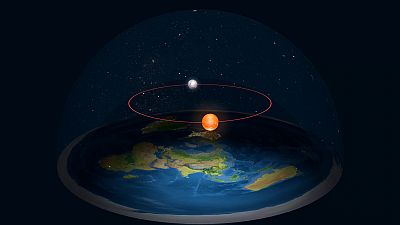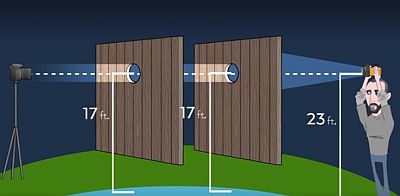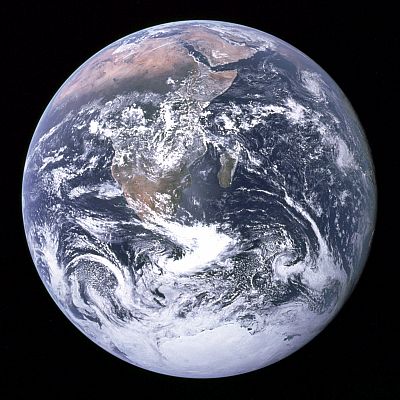GAM 2019 Blog
by Ricardo Cardoso Reis
- Published: Saturday, April 13 2019 06:45
It’s meant as a joke, but unfortunately it’s not. Two thousand years after Eratosthenes of Cyrene first calculated the circumference of the Earth, in a time where tourist space travel is almost a reality, there are still people who believe the Earth is flat.
These so called “flat earthers” believe the Earth is a disk, covered by a gigantic dome, with the Sun and the Moon rotating in circles above it, and with Antarctica being a gigantic ice wall (just like in Game of Thrones), going all around the edge of the disk. Gravity doesn’t exist – the disk is simply in a constant “upwards” motion. And all evidence to the contrary is falsified by the "round Earth conspiracy", led by NASA.

A model of a flat earth, with the Sun and the Moon rotating above it.
This goes against every proof, including photos from space that shows the Earth as a sphere (the latest from a private Israeli company), rotating around itself once every 24 hours, and orbiting the Sun in 365 days (give or take a few hours). The curvature of the Earth is the reason you see a ship “disappear” into the ocean, and the reason why, from my home in Porto (Portugal), even if I use a telescope like the VLT, I can’t see Long Island, in the USA.
But, in this fake news, post-truth era, where something shared enough times is believed to be the truth, regardless of any evidence to the contrary, this belief seems to be gaining followers.
The modern flat earth idea was born with the Bedford Level experiment, carried out in 1838 by Samuel Rowbotham, along a 10 km (6 miles) stretch of the Old Bedford River in the U.K.. With a 20 cm (8 inch) telescope, he watched as a boat with a 91 cm (35 inch) mast drifted along the river, waiting to see the mast drop below the telescope’s view, which apparently didn’t happen.
Unfortunately, Rowbotham’s observation had a flaw – he didn’t take into account the effects of atmospheric refraction which, in measurements close enough to the surface, can cause light rays to bend downwards at a rate close to the curvature of the Earth. This is the same effect which allows us to see the Sun even after it’s already below the horizon.

Schematic of refraction of light in the atmosphere.
In 1870, the experiment was reproduced by Alfred Wallace, with the line of sight set 4 meters above the water to reduce refraction, and with a pole in the middle of the course which could be used to see the "bump" caused by the curvature of the earth between the two end points. As expected, the curvature was there.
Recently, the documentary “Behind the Curve” followed flat earthers which sought to prove the Earth was flat.
In their first experiment, a twenty thousand dollar high accuracy laser gyroscope was used to prove the Earth isn’t a globe spinning at around 15 degrees per hour. If the Earth was flat, the gyroscope should stand still, but when they turned it on, they saw the gyroscope drifting about 15 degrees per hour.
In their second experiment, they tried a version of the Bedford Level experiment, using a light source, three posts of equal height over a distance of 6,5 km (4 miles), two of which with holes cut into styrofoam sheets.
If the light passed through the first hole and appeared in the camera behind the second hole, then it would have traveled straight across the surface of the flat Earth. But with the light at the same height as the holes, it didn’t appear on the camera. Only when they lifted the light, to compensate for the curvature of the Earth, was the light visible on camera.

The experiment which proves the Earth’s curvature, at the end of the documentary "Behind the Curve” (credit: Delta-V productions).
But don’t take my word for it. Test it! That’s the beauty of science – anyone can test a theory by reproducing it, as long as they have the right equipment and knowledge.
Get a stratospheric balloon filled with helium, strap-in a Go Pro camera and a gps tracker, and fly it to a height of around 30 km (about 18.5 miles). This whole apparatus should cost less than 900 euros (or 1000 American dollars) and you can have photographic proof of the curvature of the Earth. Or, if the Earth is flat, you can fly it near Antarctica, and should be able to easily photograph the “edge of the Earth”. Either way, you’ll have proof.
Or you can just wait for a lunar eclipse, and see (for free) what shape does the shadow of the Earth cast across the lunar surface.

What a “flat Earth” lunar eclipse should look like. (credit: NASA/Phil Plait)
Being sceptic is a good thing – you shouldn’t accept something just because someone tells you. But, quoting Carl Sagan: “Extraordinary claims require extraordinary evidence.” And when confronted by Space X CEO Elon Musk with the question: “Why is there no flat Mars society?”, the reply was simply: “Unlike the Earth, Mars has been observed to be round.”

Earth photographed by the Apollo 17 crew (credit: NASA)
| Ricardo Cardoso Reis works as science outreach officer at Instituto de Astrofísica e Ciências do Espaço (IA) and as planetarium producer/presenter at Planetário do Porto – Centro Ciência Viva, in Portugal. Between 2010 and 2012 he was solar activities coordinator for Global Astronomy Month. During the International Year of Astronomy 2009 (IYA2009) he was a member of the International task group and Portuguese co-coordinator for 100 Hours of Astronomy (and co-coordinator of “Sun Day” activity) and Galilean Nights; and the International coordinator of Dawn of IYA2009, the first global event of IYA2009. |  |






